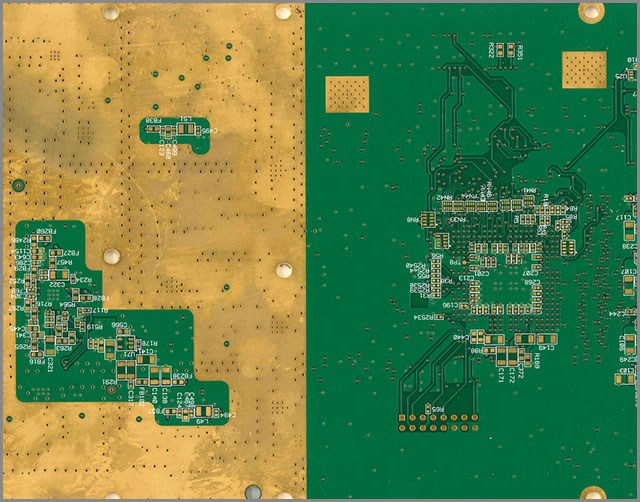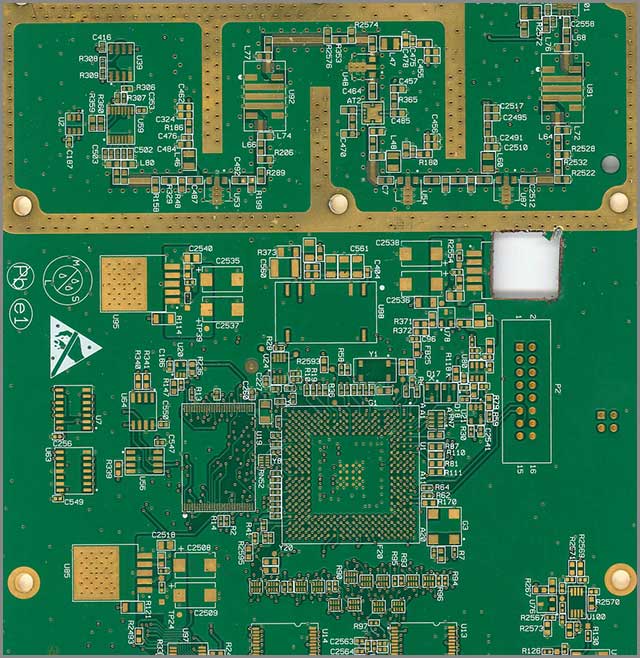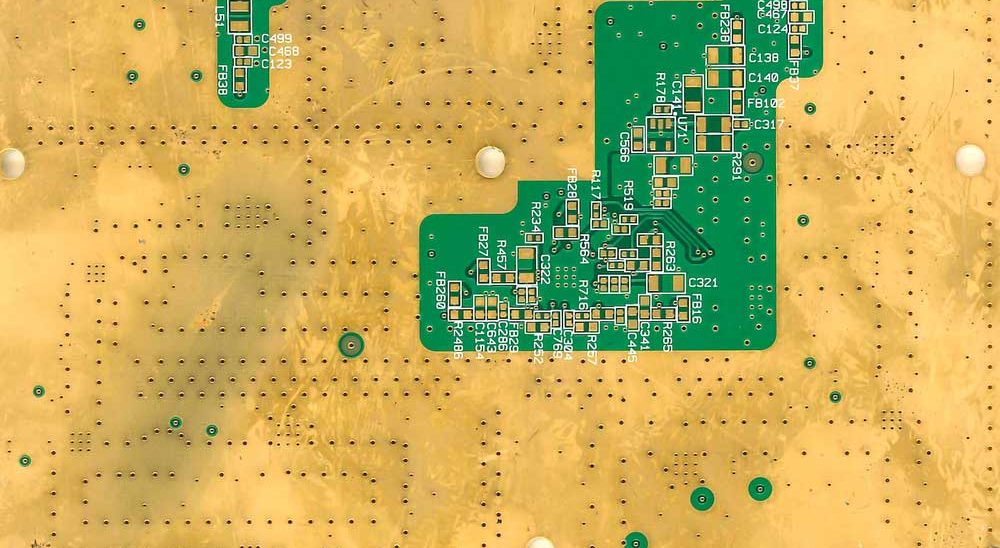Contents
- 1 PCB Surface Finish—What is PCB Surface Finish?
- 2 PCB Surface Finish— 11 Types of PCB Surface Finish & Comparison
- 2.1 PCB Surface Finish Type: Hot Air Solder Leveling (HASL)
- 2.2 PCB Surface Finish Type: Lead-Free HASL
- 2.3 PCB Surface Finish Type: Immersion Tin (ISN)
- 2.4 PCB Surface Finish Type: Immersion Silver (IAG)
- 2.5 PCB Surface Finish Type: Electroless Nickel Immersion Gold (ENIG)
- 2.6 PCB Surface Finish Type: Electroless Nickel Electroless Palladium Immersion Gold (ENEPIG)
- 2.7 PCB Surface Finish Type: Organic Solderability Preservative (OSP)
- 2.8 PCB Surface Finish Type: Hard Gold (Plating)
- 2.9 PCB Surface Finish Type: PB-Free HASL
- 2.10 PCB Surface Finish Type: Carbon Ink
- 2.11 PCB Surface Finish Type: Bare Copper
- 3 The Purpose of PCB Surface Finishes
- 4 PCB Surface Finish–How to Choose PCB Surface Finishes
- 5 FAQs
- 6 Conclusion
PCB Surface Finish—What is PCB Surface Finish?
A PCB surface finish is the coating between the bare printed circuit board and a component. PCBs with copper finish are susceptible to oxidization and deterioration if left unprotected. To this end, it becomes necessary to apply finishing for two crucial purposes:
• To protect the copper surface and circuitry
• To ready the surface for soldering associated components during assembly
Now’s take a look at the specific surface treatments and the differences between them.

PCB Surface Finish— 11 Types of PCB Surface Finish & Comparison
There are seven types of PCB surface finishes, and each comes with its advantages and shortcomings:
PCB Surface Finish Type: Hot Air Solder Leveling (HASL)
HASL is the most common surface finish. It is also the most affordable. The application process involves dipping the PCB in a solution of molten solder and then blowing off the residue using a hot air knife. The resolution of molten solder is made of lead and tin alloys.
Advantages
The most significant advantage of HASL surface finishing is that it is economical. Other advantages include:
- It allows for a larger processing window
- It applies to a wide range of PCBs
- The provides excellent solderability
Disadvantages
As mentioned, this surface finish involves dipping the board in a solution of molten solder made of lead and tin. It makes it unsuitable for panels that demand RoHS compliance. This shortcoming is tied to other disadvantages that include:
- There is a difference in thickness between large and small pads
- It is not suitable for HDI products
- It causes bridging on fine pitch
- It is not suitable for BGAs and SMDs measuring less than 20 mils in diameter.
PCB Surface Finish Type: Lead-Free HASL
Lead-free HASL is the most popular surface finish used on PCBs today. It is applied by immersing the PCB in a molten or tin alloy lead, ensuring that the entire surface is covered. Air knives are then used to blow off the residue for an even coating.
Advantages
One of the most significant advantages of lead-free HASL is that it exposes potential delamination issues by exposing the PCB to temperatures of about 2650C. Other advantages include:
- Is widely available
- It is eco-friendly
- Ensures durability
- It is re-workable
- It is affordable
Disadvantages
- It may create a thermal shock
- It may result in uneven surfaces
- It is not ideal for fine-pitching
- It may cause solder bridges
- It reduces PTH (plugged-through holes)
PCB Surface Finish Type: Immersion Tin (ISN)
Immersion Tin is the ideal surface finish for fine pitch products, planar, backplanes, and press fit. ISN is applied by initiating a chemical displacement reaction with thPCB’s’s copper surface.
Advantages
Immersion tin comes with a wide range of advantages that far outweigh its shortcomings. They include:
- Creates an even surface, unlike lead-free HASL
- It can be reworked
- It can be substituted for reflowed solder
- Is highly reliable
- It is ideal for a wide range of PCBs
Disadvantages
Tin and copper have a strong affinity with each other. It means that the diffusion of one of these metals into the other is inevitable. The result is a shorter shelf life when compared to most other PCB surface finishes. It may also limit the PCB performance. It is its most significant shortcoming. Other shortcomings include:
- Not ideal for PTH
- It can be reworked but to limited extents owing to its short shelf life
- It results in tin whiskering
- Can damage the solder mask
- It is difficult to handle and can result in a wide range of damages
- It may be unhealthy for handlers as it contains a carcinogen known as Thoreau
PCB Surface Finish Type: Immersion Silver (IAG)
Immersion Silver has been widely popular since the WEEE and RoHS directive was passed. It is considered an excellent alternative to ENIG for several reasons, chief among them being that it is ideal for fine pitch. Immersion silver is mainly used for aluminum wire bonding, membrane switches, and EMI shielding.
Advantages
One of the main advantages of immersion silver is that it contains OSP, which prevents tarnishing. However, this also makes it necessary for the PCB to be packaged immediately after application, as OSP is sensitive to contaminants on the board. Advantages of immersion silver include:
It is compliant with RoHS directives and requirements
- Suitable for fine pitch
- The moderate shelf life of about 12 months
- Highly stable when compared to other surface finishes
- Ideal for planar
- It is affordable and cost-effective
Disadvantages
As mentioned earlier, the presence of OSP makes immersion silver susceptible to tarnishing, which is its most significant shortcoming. Other shortcomings include:
- It may result in silver whiskering
- It is not suitable for compliant-pin interaction as it has a high fraction coefficient.
- Some of its systems cannot throw into micro vias aspect ratios of 1:1
PCB Surface Finish Type: Electroless Nickel Immersion Gold (ENIG)

One Person Answering Questions About Electronics
Electroless Nickel Immersion Gold is fast becoming popular in the PCB industry as it overcomes many of the significant shortcomings associated with other surface finishes. ENIG has a two-part application process. First, a nickel layer is applied to serve as both a barrier to the copper and a suitable surface on which components can be soldered. Another layer of gold is then used to protect the nickel layer for the time during which the board is in storage.
Advantages
The most significant advantage of ENIG is that it is ideal for the new and upcoming generation of complex surface components, including flip chips and BGAs; other surface finishes have shortcomings that limit their application in these new boards. Other advantages include:
- It is ideal for flat surfaces as the layers of nickel and gold as thin and even
- It does not contain lead
- Ideal for PTHs
- It has a long shelf life
Disadvantages
Although ENIG has a long shelf-life, it has also been associated with the “black pad, “a common problem that leads to the buildup of phosphorus between the layers of nickel and gold, thus resulting in fractures as well as faulty board connections. The only other major disadvantage is that it is not ideal for reworking.

Green Print Circuit Board Enig Gold
PCB Surface Finish Type: Electroless Nickel Electroless Palladium Immersion Gold (ENEPIG)
Electroless Nickel Electroless Palladium Immersion Gold (ENEPIG) PCB surface finish is an upgrade of ENIG. In ENIG, immersion gold has been shown to destroy the layer of nickel. ENEPIG introduces a layer of plating palladium between the layers of gold and nickel.
Advantages
ENEPIG has been dubbed the” universal finish” because it applies to many modern, highly advanced boards with multiple surface packages. It comes with a range of advantages that include:
- It makes for a flat surface
- Easy to process
- Idoesn’t’t have a toxic effect on the skin
- Idoesn’t’t contain lead
- Ideal for multiple reflow cycles
- It is highly compatible with Sn-Ag-Cu-based solder
- It has a long shelf life.
Disadvantages
- It often results in the occurrence of black pad
- It reduces solder joint reliability
- The layer of palladium is too thick to support solderability performance
- Takes longer to wet compared to other surface finishes
- It is affected by plating conditions
- It is expensive compared to most other surface finishes
PCB Surface Finish Type: Organic Solderability Preservative (OSP)
OSP is an organic, water-based surface finish. People sometimes refer to It as selective in its bonding with copper, and it also makes the PCB solderable.
Advantages
OSP surface finishing is notable for its environmental-friendliness since it is organic and water-based. It also makes it easy to apply, and the process is relatively short and straightforward compared to other surface finishes. Its advantages include:
- Provides an even, co-planar surface
- Requires low equipment maintenance
- It does not contain lead
- It is repairable
Disadvantages
OSP is organic and water-based. This makes it susceptible to damage during handling. Because of this, OSP has several other shortcomings:
- It has a short shelf life
- It is not suitable for PTH
PCB Surface Finish Type: Hard Gold (Plating)
Hard gold is the most expensive type of surface finish. It consists of a gold alloy layer bound to a coat of nickel, cobalt or iron. Manufacturers typically reserve it for components that will experience heavy use.
As such, manufacturers commonly use gold finish for edge connectors, test boards, interconnected carrier boards, keypads and contacts.
The thickness of the hard gold finish/plating can range from 25 to 100 micrometers depending on what applications the PCB will be used for.
For instance, electronics for industrial and military use cases require PCBs with thicker, hard gold plating.
Advantages
- Long shelf life
- Highly durable
- Lead-free
- RoHS Compliant
Disadvantages
- Very expensive
- Requires specially skilled labor
- Due to poor solderabilityit’s’s unsuitable for soldering points
- Not suitable for wire bonding
PCB Surface Finish Type: PB-Free HASL
Lead-free HASL is a more environmentally friendly version of the Hot Air soldier leveling treatment process. The technique uses solder that consists of lead-free alloy.
Advantages
- RoHS Compliant
- Environmentally friendly
- Suitable to a wide variety of application requirements and scenarios.
Disadvantages
- Poor shelf life
- Unsuitable for high-intensity or high-temperature applications
PCB Surface Finish Type: Carbon Ink
Carbon ink finishing involves applying carbon ink to PCBs using a silk screen-like process. Thickness can range from 10 to 50 micrometers. Manufacturers apply carbon ink to form protective contact surfaces for components such as switches, LCDs, and jumpers.
Advantages
- Highly conductive
- Affordable
- Suitable for solder joints and wire connections
Disadvantages
- Short shelf life
- Low protection against wear and tear
PCB Surface Finish Type: Bare Copper
The term” “bare copper fini “h” is slightly misleading. In truth, bare copper means that the manufacturer has not added any additional surface treatments or finishes to the PCB, leaving the traces and pads bare.
Advantages
- Inexpensive
- Simple
Disadvantages
- Short shelf life
- Limited to a few use cases, such as prototyping
- This leaves the board susceptible to oxidation
- Not well-suited to harsh environments
- Bare copper PCBs require careful and considerate handling
The Purpose of PCB Surface Finishes
The surface does not exclusively exist for aesthetic value. It has some very important functions for PCBs. The most obvious is its prevention of oxidation.
Conductors, particularly those consisting of copper, are highly susceptible to degradation from oxidation. Oxidation occurs when these components suffer exposure to oxygen, which can typically be found in the air. Thus, the surface finish provides the PCB with a protective layer, ensuring the reliability of the PCB in the long run.
Surface finishes also promote solderability. In fact, this is their primary function. They provide a foundation or base that makes it easier to attach components to the PCB. The absence of a surface finish increases the risk of solder defects such as bridging, tombstoning, and generally poor connections.

Soldering Electronic Circuit Board Electronic Components
In addition to improving thboard’s’s solderability, many surface finishes promote wire bonding. Not all components are attached to the PCB via solder. Semiconductor packages in particular, use wire bonding to connect to the PCB. Surface finishes can enhance this process.
PCB Surface Finish–How to Choose PCB Surface Finishes
The differences in these types of PCB surface finishes make them suitable and unsuitable for specific uses. To this end, anyone looking to apply the ideal surface finish should consider several factors:
• PCB Surface Finish–Pad Flatness
As mentioned severally, some surface finishes result in uneven surfaces that may impede performance, solderability, and other factors. If flatness is an important factor, consider surface finishes that have thin, even layers. Suitable options, in this case, include ENIG, ENEPIG, and OSP.
• Solderability and Wettability
Solderability is always a crucial factor when working with PCBs. Specific surface finishes such as OSP and ENEPIG have been shown to hinder solderability, while others such as HASL are ideal for it.
• Gold or Aluminum Wire Bonding
If your PCB requires gold or aluminum wire bonding, your options may be limited to ENIG and ENEPIG.
• Storage Conditions
As mentioned, some surface finishes, such as OSP, make PCBs fragile when handling, while others improve durability. It should be considered beforehand when taking into consideration storage and handling requirements. Only when risk-free storage and handling requirements can be met, Surface finishes that make PCBs delicate should be applied.
• Solder Cycles
How many times will the PCB be soldered and reworked? As shown, many surface finishes are ideal for reworking. Others, such as immersion tin, are not ideal.
• PCB Surface Finish–RoHS Compliance
RoHS compliance is crucial when determining the surface finish to go with. Usually, all surface finishes that utilize lead are not suitable for RoHS compliance and should be avoided.

FAQs
What is the cheapest PCB surface finish?
Many consider bare copper to be the least expensive type of surface finish. This is because the bare copper finish process adds no additional surface treatments to the PCB. If you’re looking for a surface finish that prevents oxidation and can increase, the next cheapest option is hot air solder leveling (HASL).
How thick is a PCB surface finish?
The thickness of the PCB surface finish depends on the type. For instance, the thickness of an HASL-based surface finish can be as much as 50 um or as thin as 0.2 um, and gold plating can be as thick as 100 um.
What is the difference between gold plating and immersion gold?
Gold plating tends to be thicker than immersion gold. As such, gold plating enables more full-bodied joints and is more suitable for harsh environments. Immersion gold is slightly less expensive, and it offers a more consistent coatingIt’s’s also ideal for fine-pitch SMT components.
Conclusion
As outlined, each type of surface finish has unique elements that set it apart from the rest. These elements make these finishes both suitable and unsuitable for specific applications, and the ideal option ultimately depends on the PCB’s makeup.
At WellPCB, we have vast experience with PCB boards and surface finishes. Get in touch to learn more about the different types of PCB surfaces and more! We would love to help you come up with the ideal surface finishing for your PCB.





